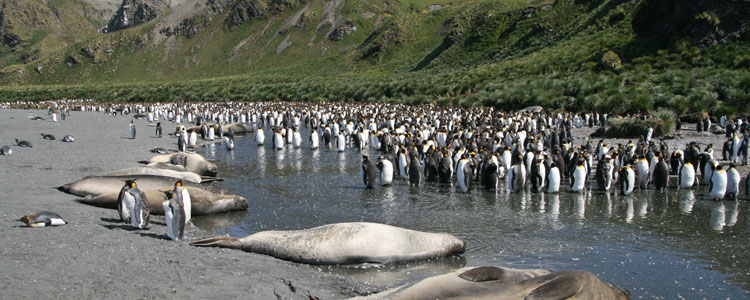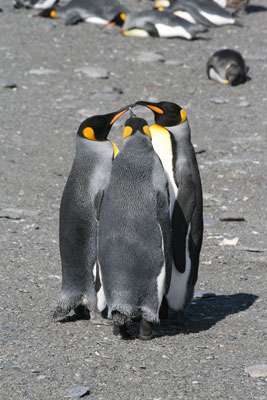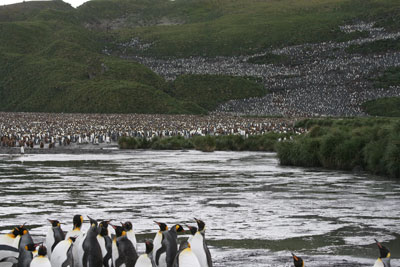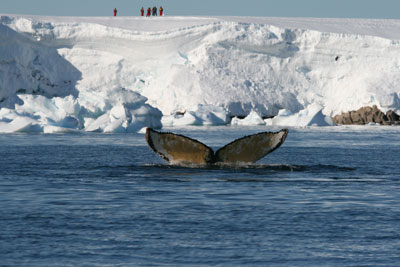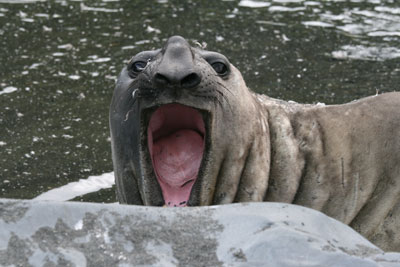Cruising Antarctica – an incredible adventure
by Bill Reed; Denton, TX If you’re planning a visit to Antarctica, there are, essentially, three types of cruises you can take. One is a short (one-week) run to Antarctica and back; another is what amounts to a “drive by,” where you don’t get off the ship, and the third — the one my wife, Betty, and I took in December ’10-January ’11 — is a long (19-day) trip around the Scotia Arc, a series of islands which include the Falkland Islands, South Georgia, the South Orkneys and the South Shetlands (plus a couple of others). On the run to the Falklands, South America protected us from the Westerlies, but after that we were subjected to pretty rough seas. Pills and patches were used with some success by just about everybody on board. On really bad days, I found that an over-the-counter pill (Bonine), music on my earphones and an hour’s rest seemed to do the trick. Others were not so lucky. However, it was worth being sick to be able to experience what we did and see what we saw. Even Betty’s breaking her arm because of rough seas at the end of our trip did not dampen our love for the experience. (She has recovered nicely.) Antarctica is truly magical. Now if asked what the best trip was that we’ve ever taken, we will be able to say that it was this Antarctic trip, which we took with One Ocean Expeditions. It beat out the Galápagos, the Okavango Delta, the Serengeti and even the Arctic.
The Falklands
To allow for airline delays, we arrived in Ushuaia, Argentina, a day and a half before our ship was to leave. From there we took a trip with Canal Fun & Adventure (9 de Julio 118, Ushuaia) to Gable Island. I would recommend both the trip ($274) and the company to anyone.
The trip involved a long drive through the mountains near Ushuaia and a long hike through the countryside, ending with a very cold boat trip to an island with hundreds of Magellanic penguins. On our second day, we went to Canal Fun to arrange a half-day trip, and they actually recommended a free walk to the Martial Glacier instead of trying to sell us a tour! Departing Ushuaia on the Marina Svetaeva that evening, we headed up the eastern coast of South America to the Falklands. The 2-day journey was accompanied by many seabirds, and the bird expert on board was in heaven, explaining each bird to anybody who would listen. In the Falklands, we visited a combined rockhopper penguin and black-browed albatross colony, where visitors could get within a few feet of the birds. I would guess there were around 500 birds nestled in isolated rocky areas surrounded by 5-foot-tall tussock grass. It was a photographer’s dream! It was there that we got a true appreciation for what rockhopper penguins have to go through to nest. From where we were, we could see the shore where they landed, but the nesting site was so far from the shore that we couldn’t make out the birds anymore. I have no idea how these little birds (they’re only about 12 inches tall) make it all the way up the steep cliffs to feed their chicks and still have any energy left for themselves. They only hop about four inches at a time, so they must make a zillion hops to get to their nests! I can’t address in this article each location we visited, but suffice it to say that each place was an experience in itself. There were no bad landings or places we wouldn’t go back to see.
South Georgia
From the Falklands, we headed to South Georgia, a 2-day passage. The strengthening winds imparted a decided list to the ship, so we had to hang on as we walked down the passageways. But, hey, if you are going to be in the roughest oceans in the world, you want to feel it, right? Along the way, we passed Shag Rocks, perfect examples of bird-covered oceanic islands. These steep, barren rocks appeared as if out of nowhere, sitting in the middle of the South Atlantic Ocean and spread out over a half mile or so. We circled the rocks twice, as groups of shags flew around the ship, before continuing on for one more day of sailing.
Early the next morning, South Georgia came into view. South Georgia Island is about the size of Rhode Island and is largely covered by ice. There are only two permanent residents on the island but hundreds of seasonal researchers. The mountains rise sharply out of the sea as black defenses against the ocean. They are stark in their beauty, with glaciers reaching to the sea in just about every valley. The thin shoreline was, for the most part, covered with penguins, fur seals and elephant seals. The wind, a constant companion, made the 34°F day seem colder, but we were dressed for it. I had three layers of pants and five layers on top, including shirts and a heavy parka with a fleece liner. It is surprising how much warmth a second shirt adds to the first one. After a brisk walk, I had to peel one layer off at a time to adjust. We queued up to board Zodiacs for the short trip to the beach. We were fortunate that, for most of the trip, we anchored in sheltered waters, so we stayed relatively dry on the trips to and back from the beaches. On our last day, however, it was different. Every wave sent a spray of cold water directly into the faces of just about everybody on the Zodiacs. Antarctic ocean spray in your face along with a strong wind and a little snow was some pretty cold stuff.
Wildlife attractions
We stopped at four different locations on South Georgia, and each one was a different experience. In each case, the rule was you could not get closer than three meters from the animals. They, on the other hand, could get closer to you if they wanted. For the most part, the fur seals wanted just that. In fact, they wanted to get close enough to bite you. They seemed to hate people and would charge if you got very close, but if you stood your ground they would stop — but only inches from being close enough to chomp down on your leg! Shouting and clapping your hands appeared to be enough to stop them. Nonetheless, it was a little unnerving.
The penguins, on the other hand, were inquisitive little critters and would come up to you and peck on your boots or, in my case, on my fingers. They didn’t bite hard at all and just seemed to want to learn a little more about me. Each walk started out with our keeping the prescribed distances, but the birds quickly either came to us or just walked right through where we were standing. We were literally surrounded by penguins and fur seals. We stayed for only a couple hours at each landing, but I could have stayed much longer. There is just nothing like it. Normally, on trips that go to South Georgia there is not time to camp for a night, but our captain was able to take a shortcut through some islands to a spot where we could camp. We each were issued a waterproof bag, called a bivy sack, plus a thin mattress and a sleeping bag. We dug a shallow depression in the snow where we were to sleep. It got down to only about 25°F, which was fortunate, as it could have been miserable. We walked over to see some sleeping seals and sank waist deep in the snow in the process. At midnight, the sun was only slightly below the horizon, turning the water into a glassy sheet of bronze. It was magic, an almost spiritual experience, and I wondered how, in my life, I got to be in this place.
A bit of history
From there we headed to Elephant Island. We must have been blessed by the travel gods because our tour leader told us that, in 15 trips, he had never been able to land at Elephant Island because it is exposed to the open sea on all sides. There are no protected harbors. Our captain was able to take the ship in close, allowing plenty of time for us to look the place over.
The most historic stop was at Grytviken, where Ernest Shackleton organized the rescue of the members of his crew, whom he had left on Elephant Island after their ship was trapped in pack ice. We motored into the harbor under broken clouds and on a calm sea. Off the starboard bow I could see a small, white fence enclosing a square patch of land no more than 100 feet on a side. In the upper left-hand corner was a large, granite monument: Shackleton’s grave. After landing, we had a group toast before we each poured a small glass of whiskey on “The Boss’s” grave, almost exactly 100 years after his death. Grytviken is a derelict whaling station (one of many) that gives visitors an idea of the enormous numbers of whales harvested from these waters. Row upon row of huge metal tanks once held the rendered oil, and lines of generators fed electricity to the factory. Two old whaling ships stood rusting in the harbor. The people are gone, the machines are rusted and the buildings are decaying. Gone, too, are the whales. They used to migrate through this area, but, overfished, they have not returned. Our last landing before heading home started out nice, with a reasonable wind and 2-foot-high seas. We landed on the rocky coast, which quickly turned to snow covered, and found foot-deep snow through which the penguins had made “highways.” There were these little paths leading from the shore up the mountain, and only the top third of each penguin was visible above the snow as they headed either up to their nest sites or down to the water. They had not figured out how to pass on their highways, though. When one coming down met another going up, they would stop and look at each other for a while, then the one coming down would turn around and go back up. We were on the beach about an hour when it started to snow and the wind picked up. It was miserable. We were dressed in several layers and had heavy jackets, but it was still cold. We were told that most of the trips are like that most of the time. I am glad we got to experience such weather, but I can only imagine how it must feel in the winter or in a really bad storm.
Evaluate the risks
This type of travel is not without some risks. The seas are rough, and the metal surfaces get coated with ice, making them virtually impossible to grasp or stand on. One gentleman slipped on the ice and broke his arm, and, as I said earlier, Betty broke her arm going up to the bridge on a very rough day. The boat rolled and a heavy door knocked her into the wall.
Another individual developed a heart condition and had to be evacuated. Had a plane not been available, it would have meant at least two days back to Ushuaia and, essentially, the end of the trip for the entire group. There is a reason One Ocean Expeditions asks so many medical questions before they sell you a ticket. This place is remote, and if something really serious happens, you better hope you have two to three days to get back to a hospital. That’s why you also need $50K of medical evacuation insurance. However, the remoteness of the place is one of its most appealing aspects. Another draw is the pristine landscape. There is no trash, no smoke and no indication (save for the few experimental stations and abandoned whaling stations) of any human presence. It is why we will go back, if at all possible. This is a trip I would recommend to anyone. I would highly recommend going to South Georgia and the rest of the Scotia Arc islands, and I would suggest going with One Ocean Expeditions (Edmonton, Alberta; phone 855/416-2326). Though they realize there is some danger associated with this type of travel, they warn you of the dangers but don’t coddle you. We were treated as reasonable adults able to make our own decisions about the amount of risk we wanted to take. I found no fault with how they ran their trip. The total cost of our 19-day cruise was $29,900, which included an alumni discount of $1,574. We paid $2,362 for the required travel insurance plus about $2,600 in international airfare from/to Dallas. This was a hugely expensive trip, but both of us would do it again in a minute.

